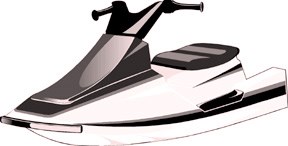
What is a Personal Watercraft (PWC)?36 CFR §1.4 - Personal watercraft refers to a vessel, usually less than 16 feet in length, which uses an inboard, internal combustion engine powering a water jet pump as its primary source of propulsion. The vessel is intended to be operated by a person or persons sitting, standing or kneeling on the vessel, rather than within the confines of the hull. The length is measured from end to end over the deck excluding sheer, meaning a straight line measurement of the overall length from the foremost part of the vessel to the aftermost part of the vessel, measured parallel to the centerline. Bowsprits, bumpkins, rudders, outboard motor brackets and similar fittings or attachments, are not included in the measurement. Length is stated in feet and inches. Special PWC Regulations, Glen Canyon National Recreation Area36 CFR §7.70(e) - PWC. (1) A person may launch and operate a PWC in park waters or beach a PWC on park lands, except in the following areas: (i) On the Colorado River between Glen Canyon Dam and the downstream river boundary of Glen Canyon National Recreation Area where it adjoins Grand Canyon National Park. (ii) On the Colorado River upstream of Sheep Canyon. (iii) On the San Juan River upstream of Clay Hills pullout. (iv) On the Escalante River upstream of Coyote Creek. (v) On the Dirty Devil River upstream of Utah Highway 95 bridge. (2) A person may not operate a PWC at speed in excess of flat wake speed on the Escalante River from Cow Canyon to Coyote Creek. (3) After December 31, 2012, no one may operate a PWC that does not meet the 2006 emission standards set by EPA for the manufacturing of two-stroke engines. A person operating a PWC that meets the EPA 2006 emission standards through the use of direct injection two-stroke or four-stroke engines, or the equivalent thereof, is not subject to this prohibition and will be allowed to operate as described in this section. (4) The Superintendent may temporarily limit, restrict or terminate access to the areas designated for PWC use after taking into consideration public health and safety, natural and cultural resource protection, and other management activities and objectives. Regarding Personal Watercraft 2-stroke vs 4-stroke EnginesThis rule only applies to personal watercrafts. Regular boats do not apply. According to the Code of Federal Regulations Title 36, 7.70(e)(3): After December 31, 2012, no one may operate a personal watercraft (PWC) that does not meet the 2006 emission standards set by EPA for the manufacturing of two-stroke engines. A person operating a PWC that meets the EPA 2006 emission standards through the use of direct injection two-stroke or four-stroke engines, or the equivalent thereof, is not subject to this prohibition and will be allowed to operate as described in this section. This rule is a part of the 2003 Record of Decision for the Environmental Impact Statement for PWC Rule-making in Glen Canyon National Recreation Area to reduce water and noise pollution. There was a ten year delay of implementation of this rule to allow PWC owners time to transition. The rule was announced in 2003 and became effective January 1, 2013. Can I modify my engine?The regulation requires a person operating a personal watercraft to meet the EPA 2006 emission standards through the use of direct-injection two-stroke or four-stroke engines, or the equivalent thereof. I have an oil injected two stroke. Is that the same as a direct injection two stroke?No. Oil injected two-strokes are still carbureted and require a fuel-oil mixture to enter the combustion chamber. Direct injection two strokes are not carbureted and fuel and oil are not mixed. Does this rule apply to all boats?Presently, the two-stroke engine ban only applies to personal watercraft (Jet-Skis, SeaDoos, WaveRunners, etc). How will park rangers determine if my engine isn't compliant?Park rangers who identify non-compliant PWCs may ask for license and registration to ensure the model is on the approved list. In some instances, especially for modified engines, the ranger may ask to see the EPA label to ensure it is compliant. Park rangers will take into account operator knowledge, the model of the vessel, the engine type, and whether it's carbureted when determining compliance with the regulation. If you do not know whether your vessel meets the 2006 EPA emission standards for two-stroke engines, please contact your manufacturer or mechanic for this information. What will happen if I bring my carbureted two-stroke PWC to the park?PWCs that are not compliant are still allowed to enter the park. However, they shall not be sold a vessel pass, and they are not authorized to launch. Rangers will utilize a wide variety of enforcement strategies that include education, warnings and citations under 36 CFR § 7.48(f)(3) for violation of this regulation. The point of the rule isn't to ticket boaters, but to ensure that the most polluting engines are kept off the lake. As time passes, the number of non-compliant PWCs will decline through attrition. How do I know if my PWC is compliant?Look at your PWC engine. Engines that meet the regulation should have an emission control information label that clearly states that they conform to 2006 or later clean emissions standards. The following information has been provided to Glen Canyon National Recreation Area by PWC manufacturers. If your vessel is not listed below and you do not know whether your vessel meets the 2006 EPA emission standards for two-stroke engines, please contact the engine manufacturer or servicing mechanic. HONDA YAMAHA
KAWASAKI
BRP SEA-DOO
Where Else Can I Take My PWC?It is best to check with federal, state, and local recreation managers for specific regulations prior to visiting a lake or river. |
Last updated: June 30, 2025
